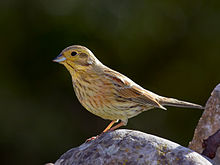Cirl bunting
| Cirl bunting | |
|---|---|

| |
| Male | |

| |
| Female | |
| Scientific classification | |
| Domain: | Eukaryota |
| Kingdom: | Animalia |
| Phylum: | Chordata |
| Class: | Aves |
| Order: | Passeriformes |
| Family: | Emberizidae |
| Genus: | Emberiza |
| Species: | E. cirlus
|
| Binomial name | |
| Emberiza cirlus Linnaeus, 1766
| |

| |
| Geographic distribution shown in green | |
The cirl bunting (/ˈsɜːrl/ SURL),[2] (Emberiza cirlus), is a passerine bird in the bunting family Emberizidae, a group now separated by most modern authors from the finches, Fringillidae.
It breeds across southern Europe, on the Mediterranean islands and in north Africa. It is a resident of these warmer areas, and does not migrate in winter. It is common in all sorts of open areas with some scrub or trees, but has a preference for sunny slopes. In the 19th century it was introduced to New Zealand and the persistent population remains in the South Island.[3]
Changes in agricultural practice have affected this species very adversely at the northern fringes of its range, and in England, where it once occurred over much of the south of the country, it is now restricted to south Devon. The cirl bunting is the mascot on the signs for the village of Stokeinteignhead in Devon.
Taxonomy
The cirl bunting was
Description
The cirl bunting is like a small yellowhammer (Emberiza citrinella), and is around 15.5 cm (6.1 in) in length with a wing-span 22–25.5 cm (8.7–10.0 in). It has a thick seed-eater's bill. The male has a bright yellow head, with a black crown, eyestripe and throat, and a greenish breast band across its otherwise yellow underparts, and a heavily streaked brown back. The female is much more like the yellowhammer, but has a streaked grey-brown rump and chestnut shoulders.[8]
The monotonous song of the cock is rattling trill, like Arctic warbler or the terminal rattle of lesser whitethroat.[9]
Distribution and habitat
The ideal farmland habitat is a mixture of grass and arable fields, divided by thick hedgerows with pockets of dense scrub.[10] They can tolerate a certain degree of urbanisation, and are found in green spaces in towns and cities, even Rome.[citation needed]
They are sedentary in nature and will often travel only 250 metres (820 ft) from their nests to forage in summer, and up to 2 kilometres (1.2 mi) in winter to find stubble.
Behavior and ecology
Breeding
Cirl buntings first breed when they are one year of age. The nest is at low level, within dense cover such as that provided by thick
Food and feeding
In the summer their natural food consists of
English population

History
A very small cirl bunting population exists in South Devon in England, near the small town of Kingsbridge where the pioneering ornithologist George Montagu discovered the species, as he recorded in his book, the Ornithological Dictionary, 1802.[12] The species appears to have first colonised Britain near Kingsbridge, most likely not long before Montagu described it. It expanded from there across southern England in the nineteenth century. It retreated from the 1930s onwards, so that by 1989 the population again survived mainly near Kingsbridge. Since then, conservation efforts have increased the population more than fivefold, but it remains almost wholly in Devon.[13]
Conservation
Through its Countryside Stewardship Scheme and environmental stewardship, Natural England has various options to conserve the species:
- Allow stubbles to overwinter. Leave crops such as spring chickweed, and annual meadow grass Poa annua, which grow in the meantime. The loss of this old farming practice led to the species' decline.
- Maintain semi-improved or rough grassland and field margins, particularly tussocky grasses such as cock's-foot. These provide an overwintering habitat for insects, which in turn provides food for the cirl bunting and their chicks.
- Sow barley-based wild bird seed mix crop. This crop has an open structure, allowing birds to forage.
- Delay spraying insecticides to provide invertebrate food for as long as possible.
- Leave hedgerows untrimmed for periods of time. This provides breeding areas and food.[14]
A partnership between Natural England and the
References
- . Retrieved 12 November 2021.
- ^ The RSPB: Projects: The Cirl Bunting Project
- ^ Angus, D. J. 2013 [updated 2015]. Cirl bunting. In Miskelly, C.M. (ed.) New Zealand Birds Online. www.nzbirdsonline.org.nz
- ^ Linnaeus, Carl (1766). Systema naturae : per regna tria natura, secundum classes, ordines, genera, species, cum characteribus, differentiis, synonymis, locis (in Latin). Vol. 1, Part 1 (12th ed.). Holmiae (Stockholm): Laurentii Salvii. p. 311.
- ISBN 978-1-4081-2501-4.
- ^ "Cirl". Oxford English Dictionary (Online ed.). Oxford University Press. (Subscription or participating institution membership required.)
- Rasmussen, Pamela, eds. (January 2021). "Sylviid babblers, parrotbills, white-eyes". IOC World Bird List Version 12.1. International Ornithologists' Union. Retrieved 22 May 2022.
- ^ Cramp & Perrins 1994, p. 170.
- ^ Cramp & Perrins 1994, p. 177.
- ^ "Farming for Birds Cirl Bunting RSPB" leaflet
- ^ Cramp & Perrins 1994, pp. 179–180.
- ^ Montagu, George (1802). Ornithological Dictionary; or Alphabetical Synopsis of British Birds, London: J. White.
- ISBN 0-7011-6907-9.
- ISBN 978-1-84754-080-5.
Sources
- ISBN 978-0-19-854843-0.
External links
- ARKive stills, video
- An RSPB guide to cirl bunting sites in Devon. Retrieved 18 May 2007
- Ageing and sexing (PDF; 4.8 MB) by Javier Blasco-Zumeta and Gerd-Michael Heinze
- Natural England and RSPB Cirl Bunting Project
- RSPB, Natural England, Paignton Zoo Cirl Bunting Re-introduction Project
- RSPB website description, including song
- Overwinter Stubbles Advice for Farmers RSPB website
- RSPB hails 'remarkable' recovery of threatened cirl bunting BBC News First Published 1 November 2016

